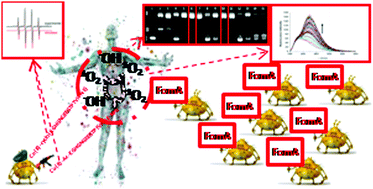当前位置:
X-MOL 学术
›
Metallomics
›
论文详情
Our official English website, www.x-mol.net, welcomes your
feedback! (Note: you will need to create a separate account there.)
ROS-mediated lipid peroxidation as a result of Cu(ii) interaction with FomA protein fragments of F. nucleatum: relevance to colorectal carcinogenesis.
Metallomics ( IF 2.9 ) Pub Date : 2019-12-11 , DOI: 10.1039/c9mt00179d Monika Katarzyna Lesiów 1 , Urszula Katarzyna Komarnicka , Agnieszka Kyzioł , Alina Bieńko , Piotr Pietrzyk
Metallomics ( IF 2.9 ) Pub Date : 2019-12-11 , DOI: 10.1039/c9mt00179d Monika Katarzyna Lesiów 1 , Urszula Katarzyna Komarnicka , Agnieszka Kyzioł , Alina Bieńko , Piotr Pietrzyk
Affiliation

|
The ability of the studied FomA protein fragments of Fusobacterium nucleatum (Fn) with copper(ii) ions (Cu(ii)-Ac-KGHGNGEEGTPTVHNE-NH2 (1Cu) and its cyclic analogue Cu(ii)-cyclo(KGHGNGEEGTPTVHNE) (2Cu)) to induce reactive oxygen species (ROS) generation, as a result of red-ox processes, was determined by UV-Vis, luminescence methods, spin trapping and cyclic voltamperometry. The contribution of 1O2 and ˙OH to DNA degradation was proved using gel electrophoresis. Furthermore, the pronounced generation of ROS by mouse colon carcinoma cells (CT26) stimulated by both copper(ii) complexes was confirmed. A fluorescence method allowed the total amounts of ROS generated inside the CT26 cells to be detected, while the spin trapping technique proved that free radicals mainly attached to the membrane surface. These last results are in agreement with the data obtained from the ICP-MS method, which demonstrates that 1Cu and 2Cu complexes are not efficiently accumulated inside the cell. Furthermore, the role of ROS in lipid peroxidation was established. The above-mentioned factors may clearly indicate the contribution of ROS generated by the studied copper(ii) complexes to colonic cell damage, which can lead to a carcinogenesis process. This study may be an important step to recognize and understand the mechanism of colon cancer initiation.
中文翻译:

ROS介导的脂质过氧化作用,是由于Cu(ii)与F.nucleatum的FomA蛋白片段相互作用所致:与大肠癌的发生有关。
具有铜(ii)离子(Cu(ii)-Ac-KGHGNGEEGTPTPHNE-NH2(1Cu)和其环状类似物Cu(ii)-cyclo(KGHGNGEEGTPTVHNE)(2Cu)的核镰孢(Fn)FomA蛋白片段的研究能力通过紫外可见,发光方法,自旋俘获和循环伏安法确定由氧化还原过程引起的活性氧(ROS)的生成)。用凝胶电泳证明了1O2和˙OH对DNA降解的贡献。此外,证实了由两种铜(ii)复合物刺激的小鼠结肠癌细胞(CT26)明显产生ROS。荧光方法可以检测出CT26细胞内部产生的ROS总量,而自旋捕获技术证明自由基主要附着在膜表面。这些最后的结果与从ICP-MS方法获得的数据一致,这表明1Cu和2Cu络合物没有有效地积累在细胞内。此外,确定了ROS在脂质过氧化中的作用。上述因素可以清楚地表明所研究的铜(ii)配合物产生的ROS对结肠细胞损伤的贡献,这可能导致癌变过程。这项研究可能是认识和理解结肠癌起始机制的重要步骤。上述因素可以清楚地表明所研究的铜(ii)配合物产生的ROS对结肠细胞损伤的贡献,这可能导致癌变过程。这项研究可能是认识和理解结肠癌起始机制的重要步骤。上述因素可以清楚地表明所研究的铜(ii)配合物产生的ROS对结肠细胞损伤的贡献,这可能导致癌变过程。这项研究可能是认识和理解结肠癌起始机制的重要步骤。
更新日期:2019-12-11
中文翻译:

ROS介导的脂质过氧化作用,是由于Cu(ii)与F.nucleatum的FomA蛋白片段相互作用所致:与大肠癌的发生有关。
具有铜(ii)离子(Cu(ii)-Ac-KGHGNGEEGTPTPHNE-NH2(1Cu)和其环状类似物Cu(ii)-cyclo(KGHGNGEEGTPTVHNE)(2Cu)的核镰孢(Fn)FomA蛋白片段的研究能力通过紫外可见,发光方法,自旋俘获和循环伏安法确定由氧化还原过程引起的活性氧(ROS)的生成)。用凝胶电泳证明了1O2和˙OH对DNA降解的贡献。此外,证实了由两种铜(ii)复合物刺激的小鼠结肠癌细胞(CT26)明显产生ROS。荧光方法可以检测出CT26细胞内部产生的ROS总量,而自旋捕获技术证明自由基主要附着在膜表面。这些最后的结果与从ICP-MS方法获得的数据一致,这表明1Cu和2Cu络合物没有有效地积累在细胞内。此外,确定了ROS在脂质过氧化中的作用。上述因素可以清楚地表明所研究的铜(ii)配合物产生的ROS对结肠细胞损伤的贡献,这可能导致癌变过程。这项研究可能是认识和理解结肠癌起始机制的重要步骤。上述因素可以清楚地表明所研究的铜(ii)配合物产生的ROS对结肠细胞损伤的贡献,这可能导致癌变过程。这项研究可能是认识和理解结肠癌起始机制的重要步骤。上述因素可以清楚地表明所研究的铜(ii)配合物产生的ROS对结肠细胞损伤的贡献,这可能导致癌变过程。这项研究可能是认识和理解结肠癌起始机制的重要步骤。











































 京公网安备 11010802027423号
京公网安备 11010802027423号